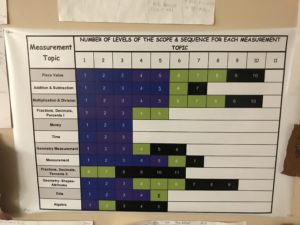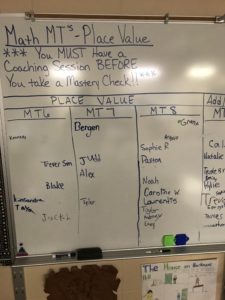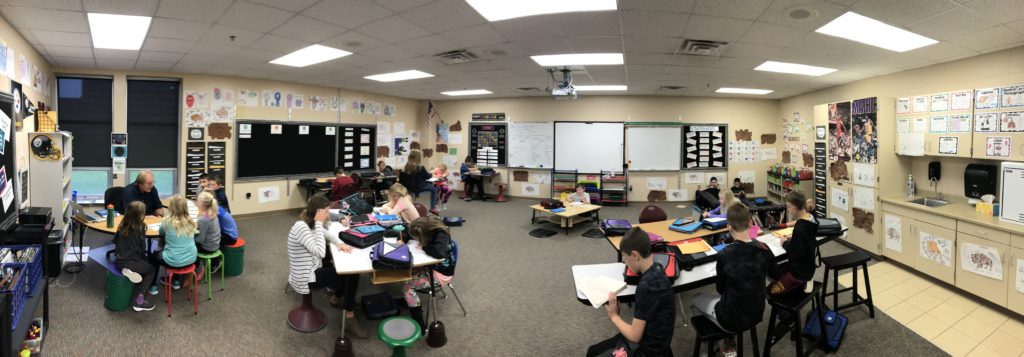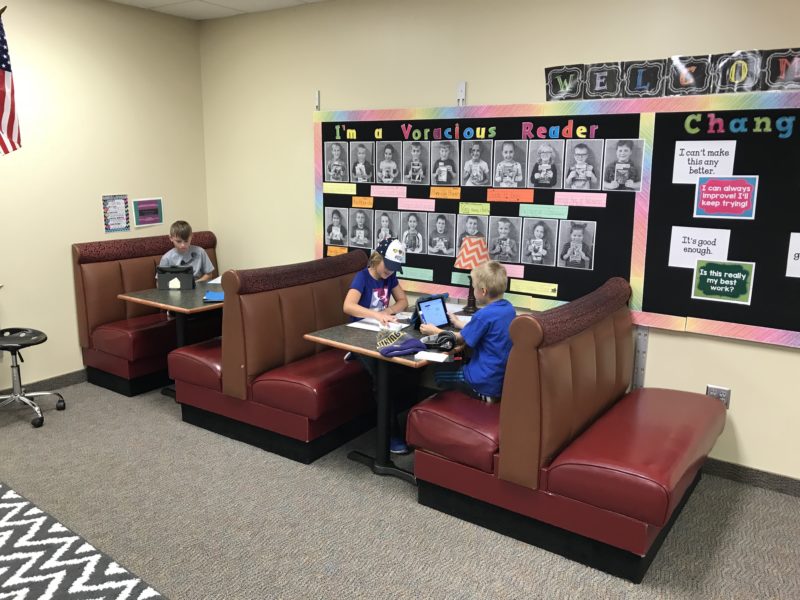As I posted in my last blog, the personalized learning tracks in Harrisburg School District south of Sioux Falls, South Dakota, REALLY opened my eyes. Here is part two of my report: the elementary schools.

The sequence of learning units is posted in each classroom so students can see where they are and what is coming next.
The personalized learning cohorts in Harrisburg elementary schools combine all student in grades 2-5. In the areas of math and literacy, students are allowed to move at their own best pace through a series of scaffolded learning units, grouped with other students who are moving through the same units. Each morning after an opening gathering, students go to the classroom where a teacher has taken responsibility for a particular set of learning units.

Students keep track of who is doing which unit of work.
Each student has an iPad which tracks their progress through the units. It offers assessments to test mastery, and then leads the students on what to do next. The students are NOT working nose-down all day on their iPads; those are merely a guide, and contain some of the work the students need to accomplish. The lessons are not pre-canned from some outside source. The teachers have uploaded lessons for the students and created these learning units themselves. From what I saw, student time is a combination of individual work on their tablet; individual work with other sources like books and worksheets; collaborative work with other students in their shared unit; work with manipulatables; time in small group coaching sessions with the teacher; and all-class activities.
On the board in each room, the units that are being covered in that room for that day or week are listed, and each student name is placed in their respective unit. One might think that students would not want to see that they are “behind” others; in speaking with them that problem never came up. In fact, they told me that they like to see who else is working on what they are, so they know how to form groups. Also, and this is fascinating to me, the students learn that their first line of support if they have a question or want help, is to ask a peer who is either in their own unit or has already mastered that unit. Their next line of help is to the teacher. Students give each other “badges” for being helpful!
Every room I visited was orderly and all students were on task. There was interaction and conversation, but it was all in a way as to not disturb others. The teachers were largely focused on helping students in their coaching sessions, and all students cycle through the coaching sessions. Two young boys told me that the teachers can, at any time, see what students are doing on their iPads, so there is a deterrent to inappropriate use. My sense was that there were few youngest students working in classes with the oldest students, but other than that the label of “grade level” was absent.
 My host, Travis Lape, told me that overall test scores have gone up in the personalized learning teams, largely because the lower-scoring students are getting the help they need while the higher-scoring students are certainly not suffering! The students of all ages were able to show and tell me what they were working on, and why. I watched a number of rooms over a period of more than an hour and did not see any indication of stress or frustration by any student. (See Travis’ blog page for much better articulation of the program.)
My host, Travis Lape, told me that overall test scores have gone up in the personalized learning teams, largely because the lower-scoring students are getting the help they need while the higher-scoring students are certainly not suffering! The students of all ages were able to show and tell me what they were working on, and why. I watched a number of rooms over a period of more than an hour and did not see any indication of stress or frustration by any student. (See Travis’ blog page for much better articulation of the program.)
One of the most impactful takeaways I had was in talking with some of the teachers who have shifted over from their traditional classroom to the personalized learning track. The speed with which they have become comfortable in the new track surprised me. One teacher told me that they started PD on the new system in June, and now, in October, her comfort level is “7 of 10”. Another teacher who started the track last year told me that it took until November to feel comfortable. This is a remarkable trajectory, in my experience. And, all of the teachers I spoke with told me that they would never want to go back to their traditional teacher-centric model of learning.
My bottom line: I would put my own kids into this elementary school in a heartbeat. If I could combine the personalized pathways of Harrisburg with the design skills and creativity of students at Design 39 Campus I would have a new “Ben and Jerry’s” flavor that would take over the world of elementary education!
Next post: the middle and high schools at Harrisburg SD.












Leave A Comment